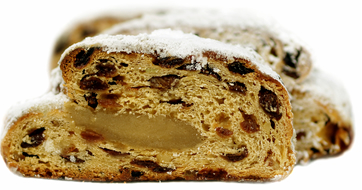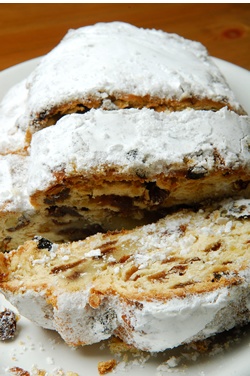Stollen (Christstollen)
The Christstollen, or just "Stollen," is a formed cake filled with dried fruits and nuts and covered in powdered sugar. It is available only during Advent and Christmas time. Its shape is supposed to resemble the Christ Child wrapped in a blanket.
The dough of the Stollen is heavy and thick. Its main ingredients are butter or margarine, flour, candied lemon and orange peels, and dried fruits, such as raisins. Additional ingredients can be used. These then determine the type of Stollen the cake becomes.
Types of Stollen
Almond-Stollen (Mandelstollen)
This is a Stollen in which the dough contains a minimum of 20 grams of almonds for every 100 grams of flour. Sometimes almond-paste is added, however this is not traditional.
Butterstollen
This Stollen contains at least 40 grams of butter or butter-fat for every 100 grams of flour. It must also contain 70 grams of dried fruits and candied orange and lemon peels. Of this 70 grams, 10 grams may be from almonds or marzipan.
Poppyseed-Stollen (Mohnstollen)
This Stollen contains a minimum of 20 grams of poppyseeds for every 100 grams of flour. Usually this is added as a filling and not simply mixed throughout the dough. Dried fruits and candied orange and lemon peels may or may not be added to the dough.
Nut-Stollen (Nuss-Stollen)
This is a Stollen in which the dough contains a minimum of 20 grams of finely chopped nuts for every 100 grams of flour.
Quarkstollen
This Stollen contains 40 grams of Quark or a dried quark product, as well as 20 grams of butter or margarine, for every 100 grams of flour. Dried fruits and candied orange and lemon peels may or may not be added to the dough.
Schittchen
This is the name for a Stollen in the German state of Thuringia (Thüringen). It is considered a specialty of the city of Erfurt. The Schitten is recognizable by the slit length-wise across the top of it. The ingredients of the Schitten include:
| • |
Flour, yeast, milk, sugar, vanilla sugar, butter and/or lard |
| • |
Candied lemon and orange peels, raisins |
| • |
Chopped and ground almonds, as well as almond extract |
| • |
Rum or brandy |
| • |
Powdered sugar for dusting the finished cake |
Dresdner Stollen
The Dresdner Stollen is the most well known kind of Stollen. For a Stollen to be allowed to carry this name, it must have been baked in the city of Dresden or in the surrounding area. For every 10 grams of flour, the Dresdner Stollen must contain at least 3 grams of butter or milk fat, 7 grams of dried fruits and candied orange and lemon peels, and 1 gram of almonds. Only those Stollen that meet these requirements can be called "Dresdner Stollen" and carry the official Dresder Stollen seal (as displayed here).
After baking, the Stollen must be stored for at least 3 weeks in a cool, dark place. This gives the dried fruits within the cake a chance to absorb moisture, thereby giving the Stollen a moist texture.
Marzipanstollen
This Stollen contains Marzipan, which must account for 5% of the Stollens total weight.
Persipanstollen
This Stollen contains Persipan, which must account for 5% of the Stollens total weight.

Photo: © nmonckton - BigStockPhoto.com |
|



The history of the Stollen begins in 1329 in the city of Naumburg in the region of Thuringia (Thüringen). It was created as a Christmas offering for the Bishop. The form, which has remained the same to today, was to resemble the Christ Child wrapped in a blanket.
Back then, the Stollen was as a light bread for the Catholic Advent fasting time. Because the Catholic Church prohibited the use of butter during fasting times, the stollen could only be made from oats,flour, water, and turnip oil. It must have tasted bad because the Bishop, in 1430, went to the Pope to request the ban on butter to be lifted. His request was rejected. They had to wait until 1491, when Pope Innozenz VIII lifted the butter ban for Stollen.
Several years later, the baker Heinrich Drasdo in the city of Torgau (in the region of Saxony) decided to modify the pre-Christmas fasting stollen to a Christmas Stollen by adding several tasty ingredients, such as fruits. His Stollen was called the "Drasdoer Stollen" and was known in all of Saxony.
The Stollen has evolved over the years, but the Stollen that we know today has really come about in the last century. Today, high quality ingredients, natural flavorings, and exotic spices are used. There is no one single recipe for the Stollen. Each baker has his/her own family tradition for baking a delicious Stollen. |
|

